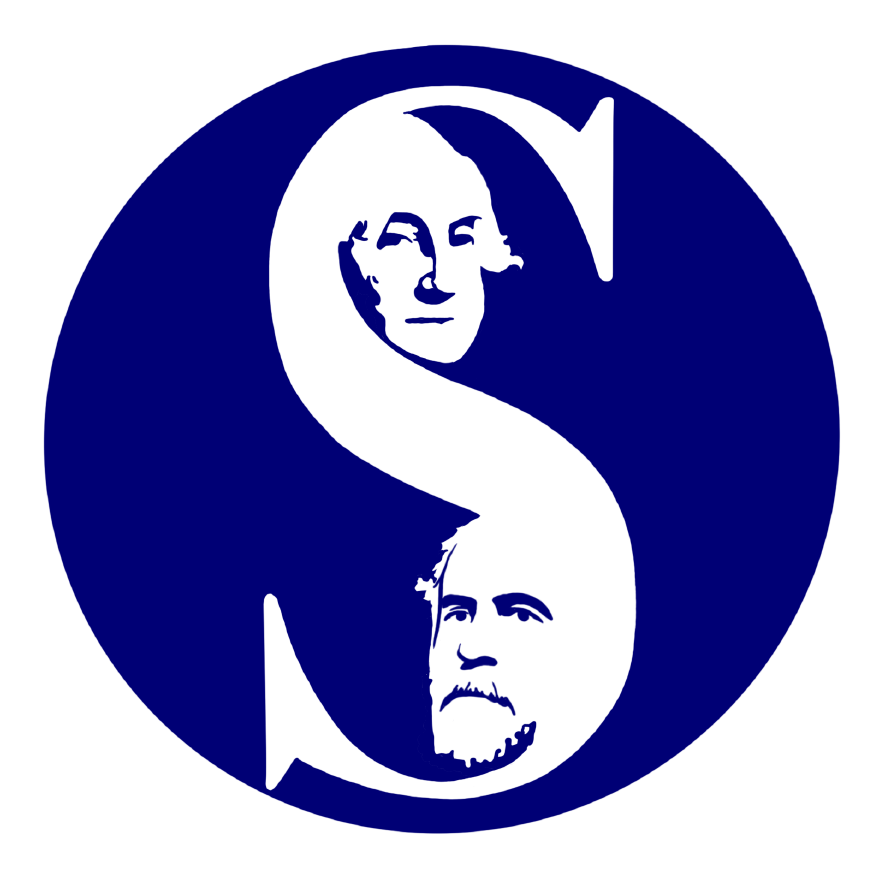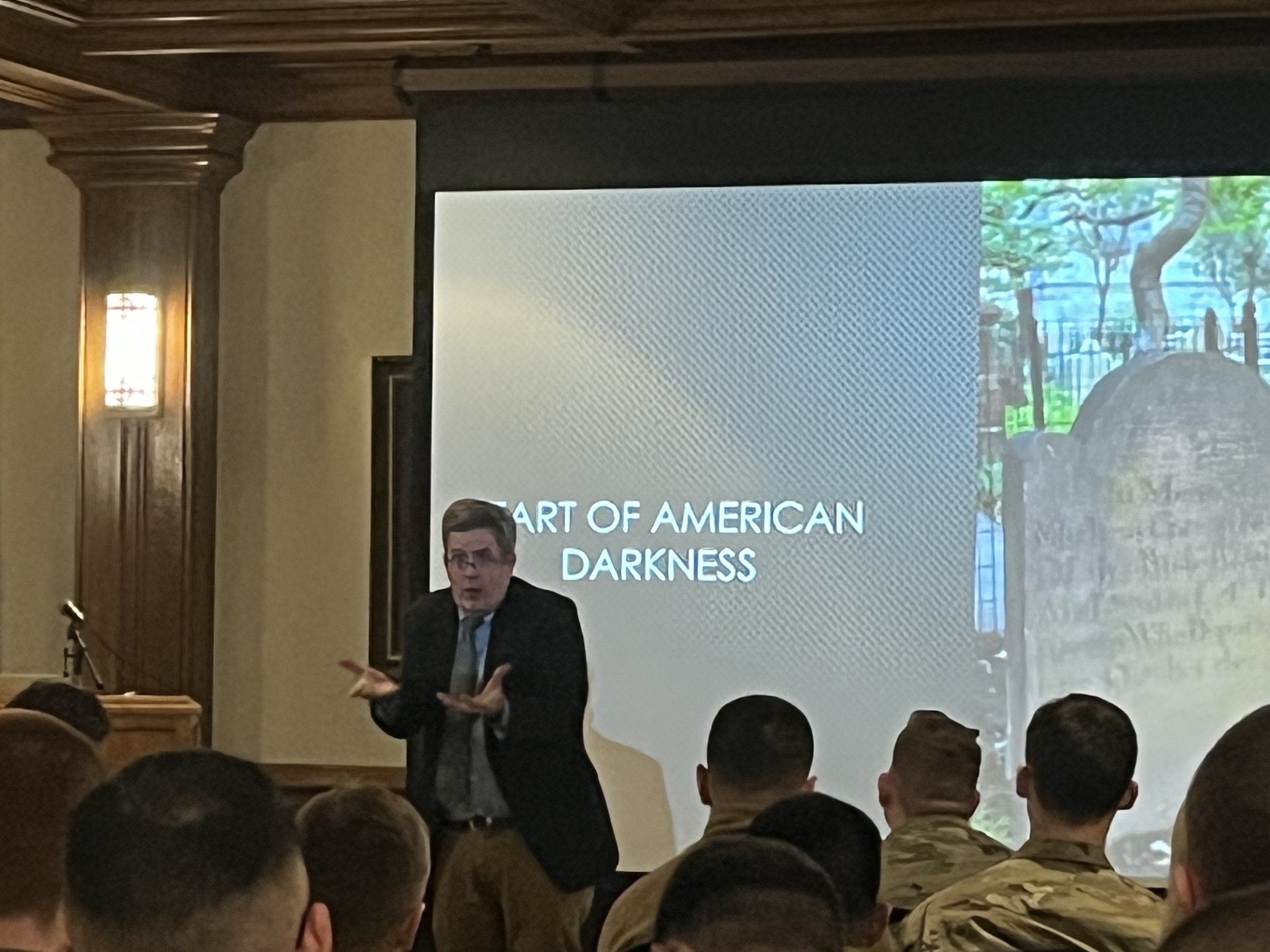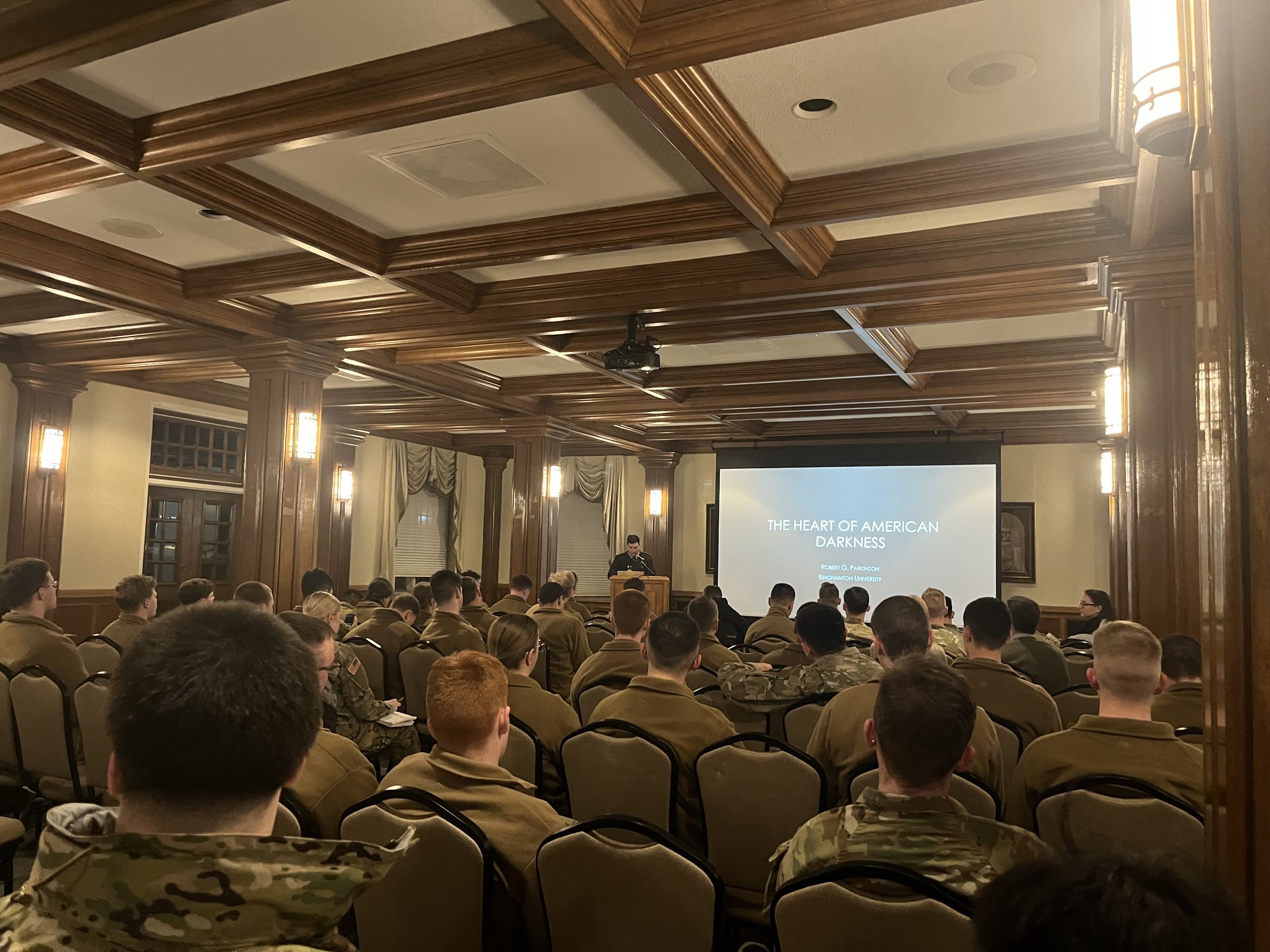Historian Overviews Western Virginia During Revolutionary War
Historian Overviews Western Virginia During Revolutionary War
Historian Robert G. Parkinson uses regional conflicts to describe “belonging and citizenship” in the Revolutionary era.
(Professor Robert Parkinson describes his research to Virginia Military Institute cadets. | SOURCE: Author)
Robert G. Parkinson, a Professor of History at SUNY Binghampton, spoke to a packed crowd at the Virginia Military Institute’s Moody Hall on February 19, 2025. Parkinson, whose research focuses on colonial and early American history, promoted his recent book, Heart of American Darkness: Bewilderment and Horror on the Early Frontier.
Parkinson’s scholarship revolves around “belonging and citizenship, of inclusion and exclusion at the founding of the American Republic.” He used the story of Captain Michael Cresap, a western Virginian frontiersman, to discuss these themes during the leadup to the American Revolution.
Parkinson, familiar with the Virginias from his time studying at the University of Virginia and teaching at Shepherd University in West Virginia, intimately described the region’s influence on the early American Revolutionary War. He later used the title of his book, a reference to Joseph Conrad’s classic novella Heart of Darkness, to compare the confluence of empires and violence in 18th-century America to that of 19th and 20th-century Africa.
(Parkinson uses different covers for Conrad’s Heart of Darkness to describe the mysterious feeling of the work. | SOURCE: Author)
Parkinson started from the premise that the American colonies were “very disunited” headed into the Revolutionary War — even “more disunited than united.” He argued that two main factors brought the colonies together: the issue of race and the embrace of “the political theory of citizenship.”
Parkinson argued that the specter of Native American and black collusion with the British helped to unite the colonies. “Those stories about people of color acting against this republic-making project solved the very difficult problem of union,” he said.
To Parkinson, citizenship allowed the colonists to decide who was included and excluded from their burgeoning polity. “Citizenship is very different than being a subject of a king, whereby the king or queen decides … who’s part of the body politic … We decide. We, the people, decide who’s in and who’s out,” he said. “And that’s the leap into the dark that happens in 1776,” he continued.
To flesh out inclusion and exclusion in colonial America, both racially and through citizenship, Parkinson heavily sourced from colonial newspapers, which he described as his “jam.” Parkinson contrasted two newspaper issues, The Virginia Gazette’s issue from July 19, 1776, and The New York Gazette and Daily Mercury’s issue from October 23, 1775.
The former, disseminating the newly-signed Declaration of Independence to Virginians, was printed on a normal-looking page, with no bold headings or attention drawn to its contents. The latter, covering the funeral of Captain Cresap, included extensive illustrations of the funeral procession, which were difficult and expensive at the time. “If the Declaration of Independence is still super boring, then this dude must be really interesting for them,” Parkinson said. “Who’s in the coffin that would merit this kind of attention?” he asked.
He then described how the Gazette and Daily Mercury piece was an obituary to Captain Cresap, praising him for “his prudence, firmness, and intrepidity as a brave officer,” and claiming that the colonies were “deprived of a worthy and esteemed citizen.” Parkinson then began the story of Cresap, the son of famed frontiersman Colonel Thomas Cresap, and how he “came to be in that funeral procession in New York City, in a place he’d never been before.”
Parkinson explained Cresap’s family history. His father had settled in a frontier region near modern Cumberland, Maryland, in the 1730s. This period saw the region in which he moved, including the Ohio Valley, as the confluence of British, French, and native influences, and it quickly became a valuable real estate.
The French and Indian War, which Parkinson argued “should be called World War I,” was fought over control of the region, “and Thomas Cresap and his young son were a key factor in starting this war.” The war, which caused the death of Michael’s brother, was just the beginning of Michael’s violent life.
Moving to what is now West Virginia, the younger Cresap set up a store on the Ohio River. One of many to violate the Proclamation of 1763’s banning of western settlement, Cresap’s move brought him into further contact with George Washington, who had been a friend of the Cresap family.
“At the start of the 1770s in the Ohio region, things were very, very messy, even worse than before,” Parkinson said. Territorial disputes abounded, both between natives and colonists, and also between the colonists themselves, with only small garrisons of British regulars to keep the peace.
“So in 1772, in order to save money, the British give orders to pull anyone out who might enforce order in this very, very chaotic” region, leading to both Virginia and Pennsylvania rushing men to Fort Pitt (modern Pittsburgh) to claim it as their own. “And if you’re a native person, and anywhere in the area, you’re looking at this thinking, ‘This is probably going to back up on us and be bad for us,’” Parkinson said.
With each group unhappy — the colonists at the crown for barring western settlement, and natives for continued, illegal white encroachment — tensions were at a tipping point. After the Boston Tea Party and with hostilities with Britain eminent, Virginia put their frontier settlements on alert for native attacks, something Cresap responded to by firing on native boats passing on the Ohio River.
(Parkinson lectures to a room of mostly VMI cadets. | SOURCE: Author)
Simultaneously, 45 miles to the north, seven Mingo tribe members, including a woman and child, were brutally slaughtered near Yellow Creek, after being lured to parlay with white settlers. The massacre, perpetrated by Virginian Daniel Greathouse, killed “almost all of the family of a Mingo leader named Logan.”
Logan, after killing 13 white settlers to exact revenge, wrote the speech titled “Logan’s Lament,” blaming the tragedy on Michael Cresap. The speech would eventually become widely popularized, mainly through Thomas Jefferson’s inclusion of it in his Notes on the State of Virginia. Parkinson said he “100% guaranteed” that VMI cadets in the 19th century would have memorized it.
Despite Cresap having nothing to do with the murders, “Logan thinks he did,” and the story of Cresap’s atrocity and the violence it caused spreads like wildfire. “As one report put it, ‘The destruction lately affected upon the son of Colonel Cresap is likely to be productive of consequences fatal to many people in the backcountry,’” Parkinson described. “The most staunch Patriot papers in Boston and Philadelphia refer to the Yellow Creek attack as barbarous murder,” he added.
Some papers began to inflate the number of Indians Cresap had killed, with one claiming 39 dead. Viewing this as an opportunity, Virginia’s royal governor, Lord Dunmore, raised an army and waged the single campaign of what would come to be known as Lord Dunmore’s War. With a decisive, but costly victory over Mingo and Shawnee warriors at the Battle of Point Pleasant, in what is today West Virginia, “Dunmore returned to Williamsburg in January 1775, fancying himself a hero and he is beloved.”
(Depiction of the Battle of Point Pleasant. | SOURCE: Thrilling Adventures Among the Indians / John Forst).
Yet, within 1775, Dunmore would become reviled and would be chased out of Virginia, and Cresap would have his reputation completely resuscitated, receiving a hero’s funeral. “He’s a murderer in one year, he’s a hero in the next year. What happened?” Parkinson asked.
“To make a long story short, the Revolutionary War happened,” he answered, continuing, “His redemption began when Cresap answered his country’s call.” “Immediately upon hearing the news of the battles of Lexington and Concord, Cresap assembled a rifle company and started marching from the Ohio River to Boston,” he described.
Cresap’s men made the 600-mile journey in an impressive 24 days, gaining “a tremendous amount of newspaper coverage. Cresap’s rough frontiersmen, who became noted for the unique dress, “looked and acted like natives, but they seemed to be coming to America’s rescue, to liberty’s rescue.” “Now, Cresap’s reputation is utterly and totally transformed,” he said.
Parkinson expounded on this seeming flexibility of reputation, arguing that revolutions are often “marked by contingency, fears, and openness,” allowing drastic and unpredictable changes. One example of this was early America’s alliance with the French, who went “from hated enemies to savior allies in a similar kind of … instantaneous turnabout.”
Yet, this flexibility, the time “that’s ripe for tremendous reevaluation,” did not result in every group becoming more accepted by the colonists. “Lots and lots of stories sponsored by Patriot leaders about slaves and Indians working for the king reinforced ideas about who belonged to the American republic and who didn’t.”
So, just as slaves and Indians began to be the villains of Patriot propaganda, “they also needed heroes, and that’s where Michael Cresap comes in.” “He goes from Indian killer to America’s savior almost overnight,” Parkinson added.





